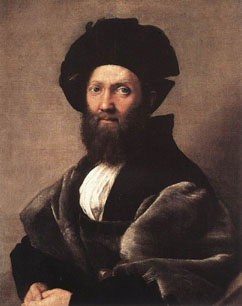| Baldassare Castiglione  Born: 6-Dec-1478 Born: 6-Dec-1478
Birthplace: Casanatico, Italy
Died: 7-Feb-1529
Location of death: Toledo, Spain
Cause of death: unspecified
Gender: Male
Religion: Roman Catholic
Race or Ethnicity: White
Sexual orientation: Straight
Occupation: Author, Diplomat Nationality: Italy
Executive summary: Il Cortegiano Italian diplomat and man of letters, born at Casanatico near Mantua, and was educated at Milan under the famous professors Merula and Chalcondyles. In 1496 he entered the service of Lodovico Sforza, Duke of Milan, returning to Mantua in 1500 when Lodovico was carried prisoner into France. In 1504 he was attached to the court of Guidobaldo Malatesta, Duke of Urbino, and in 1506 he was sent by that prince on a mission to King Henry VII of England, who had before conferred on Federigo Malatesta, "the Good Duke", the most famous mercenary of his age, the order of the Garter. Guidobaldo dying childless in 1508, the duchy of Urbino was given to Francesco Maria della Rovere, for whom Castiglione, envoy at the court of Pope Leo X (Medici), obtained the office of generalissimo of the Papal troops. Charged with the arrangement of the dispute between Pope Clement VII (Medici) and Charles V, Castiglione crossed 1524 into Spain, where he was received with highest honors, being afterwards naturalized, and made Bishop of Avila. In 1527, however, Rome was seized and sacked by the Imperialists under Bourbon, and in July of the same year the surrender of the castle of Sant' Angelo placed Clement in their hands. Castiglione had been tricked by the emperor, but there were not wanting accusations of treachery against himself. He had, however, placed fidelity highest among the virtues of his ideal "courtier", and when he died at Toledo in 1529 it was said that he had died of grief and shame at the imputation. The emperor mourned him as "one of the world's best cavaliers." A portrait of him, now at the Louvre, was painted by Raphael, who disdained neither his opinion nor his advice.
Castiglione wrote little, but that little is of rare merit. His verses, in Latin and Italian, are elegant in the extreme; his letters (Padua, 1769-71) are full of grace and finesse. But the book by which he is best remembered is the famous treatise, Il Cortegiano (The Book of the Courtier), written in 1514, published at Venice by Aldus in 1528, and translated into English by Thomas Hoby as early as 1561. This book, called by the Italians Il Libro d'oro, and remarkable for its easy force and undemonstrative, elegance of style no less than for the nobility and manliness of its theories, describes the Italian gentleman of the Renaissance under his brightest and fairest aspect, and gives a charming picture of the court of Guidobaldo da Montefeltre, duke of Urbino, "confessedly the purest and most elevated court in Italy." In the form of a discussion held in the duchess's drawing-room -- with Elizabetta Gonzaga, Pietro Bembo, Bernardo Bibbiena, Giuliano de Medici, Emilia Pia, and Ceretino the Unique among the speakers -- the question, "What constitutes a perfect courtier?" is debated. With but few differences, the type determined on is the ideal gentleman of the present day.
Father: Cristoforo Castiglione (d. 1499)
Wife: Ippolita Torelli (m. 1516, d. 1521 in childbirth, 2 children)
Requires Flash 7+ and Javascript.
Do you know something we don't?
Submit a correction or make a comment about this profile
Copyright ©2021 Soylent Communications
|